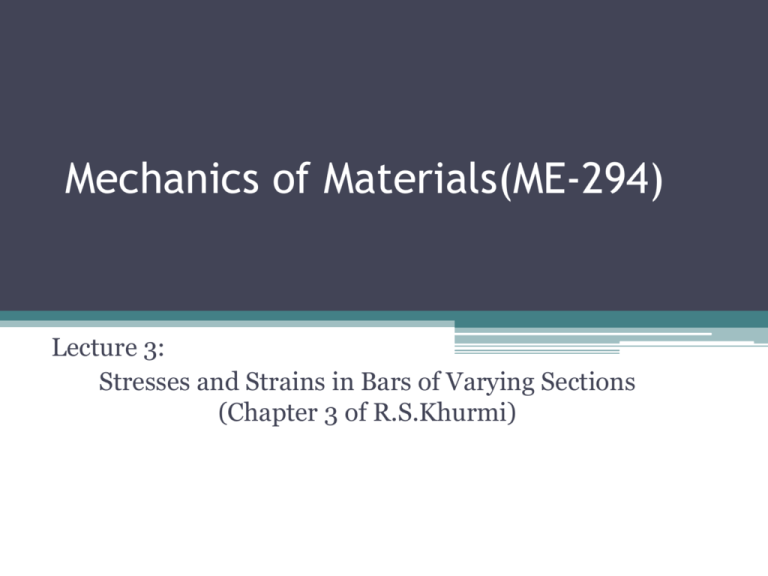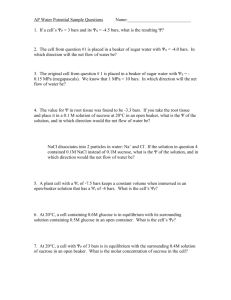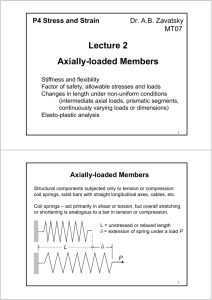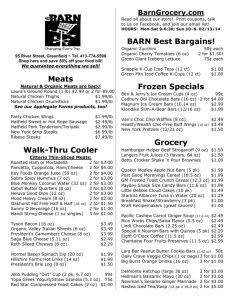Mechanics of Materials(ME-294)
advertisement

Mechanics of Materials(ME-294) Lecture 3: Stresses and Strains in Bars of Varying Sections (Chapter 3 of R.S.Khurmi) Quiz-1 ME-294 Types of Bars of varying sections • Bars with different sections • Bars of uniformly tapering sections • Bars of Composite sections The elongation of a Prismatic bar • The elongation of a prismatic bar subjected to a tensile load P is shown the following equation for the elongation of the bar: • This equation shows that the elongation is directly proportional to the load P and the length L and inversely proportional to the modulus of elasticity E and the cross-sectional area A. The product EA is known as the axial rigidity of the bar. • Above Eq. was derived for a member in tension, it applies equally well to a member in compression, in which case δ represents the shortening of the bar. When that happens, elongation is usually taken as positive and shortening as negative. • The change in length of a bar is normally very small in comparison to its length, especially when the material is a structural metal, such as steel or aluminum. A prismatic bar is a structural member having • a straight longitudinal axis and • constant cross section throughout its length. Although we often use circular bars in our illustrations, structural members may have a variety of cross-sectional shapes, such as • Solid cross sections • Hollow or tubular cross sections • Thin-walled open cross sections Two Possibilities. All sections consist have •Same material(Young’s Modulus is same) •Different materials(each section has different value of E) Stress in Bars of Uniformly Tapering Circular X-Section • Consider a circular bar of uniformly tapering section as shown in figure. Let P = Force applied on bar (Tensile) (N) L = Length of the bar (m) d1 = Diameter of the bigger end of the bar (m), and d2 = Diameter of the smaller end of the bar (m) Now, consider a small element of length dx, of the bar, at a distance x from the bigger end as shown in figure. Diameter of the bar at a distance x, from the origin, d = d1 – (d1 – d2) / L.x Let …(1) k = (d1 – d2) / L ⇒ d = d1 – kx Thus, cross-sectional area of the bar at this section. A = π/4 (d1 – kx)2 …(2) Stress: Ó = P/π/4 (d1 – kx)2 = 4P/π(d1 – kx)2 And Strain ε = Ó/E = 4P/πE(d1 – kx)2 …(3) …(4) Elongation of the elementary length = ε = dx = 4P.dx / πE(d1 - kx)2 Therefore, total extension of the bar may be found out by integrating the equation (5) between the limits x = 0; x = L. • Extension or contraction of bars is equal • Total external load on the bars is equal to the sum of loads carried by each bar Engineering , Strength and Structure • Engineering has been aptly described as the application of science to the common purposes of life. •In fulfilling that mission, engineers design variety of objects to serve the basic needs of society. These needs include housing, agriculture, transportation etc. • Factors to be considered in design include functionality, strength, appearance, economics, and environmental effects. • However, when studying mechanics of materials, our principal design interest is strength, that is, the capacity of the object to support or transmit loads. • Objects that must sustain loads include buildings, machines, containers, trucks, aircraft, ships, and the like. • For simplicity, we will refer to all such objects as structures; thus, a structure is any object that must support or transmit loads. Factors of safety • Since strength is the ability of a structure to resist loads, the preceding criterion can be restated as follows: The actual strength of a structure must exceed the required strength. The ratio of the actual strength to the required strength is called the factor of safety n: • n > 1.0 if failure is to be avoided. Depending upon the circumstances, factors of safety from slightly above 1.0 to as much as 10 are used. • If the factor of safety is too low, the likelihood of failure will be high and the structure will be unacceptable; if the factor is too large, the structure will be wasteful of materials and perhaps unsuitable for its function (for instance, it may be too heavy). Factors of safety • The incorporation of factors of safety into design is not a simple matter, because both strength and failure have many different meanings. Strength may be measured by the ▫ load-carrying capacity of a structure, or ▫ it may be measured by the stress in the material. • Failure may mean ▫ the fracture and complete collapse of a structure, ▫ or it may mean that the deformations have become so large that the structure can no longer perform its intended functions. • The latter kind of failure may occur at loads much smaller than those that cause actual collapse. • The provisions of codes and specifications are intended to provide reasonable levels of safety without unreasonable costs. • An allowable stress (or working stress) based on yield stress that must not be exceeded anywhere in the structure. Thus, • In building design, a typical factor of safety with respect to yielding in tension is 1.67; thus, a mild steel having a yield stress of 36 ksi has an allowable stress of 21.6 ksi. • Sometimes the factor of safety is applied to the ultimate stress instead of the yield stress. This method is suitable for brittle materials, such as concrete and some plastics, and for materials without a clearly defined yield stress, such as wood and highstrength steels. • Factors of safety with respect to the ultimate strength of a material are usually larger than those based upon yield strength. In the case of mild steel, a factor of safety of 1.67 with respect to yielding corresponds to a factor of approximately 2.8 with respect to the ultimate strength. Assignment=2 • Exercise 3.1 Q-2,5 • Exercise 3.2 Q-1,3 • Exercise 3.3 Q-3





